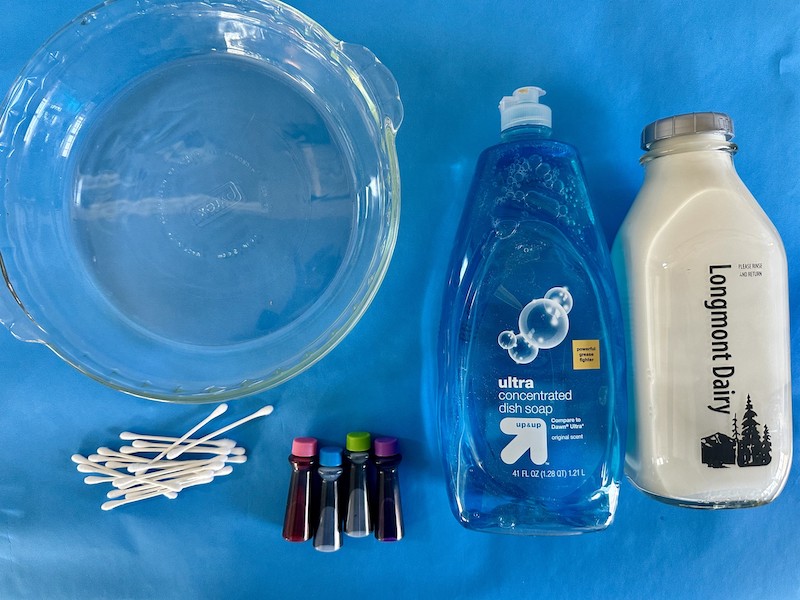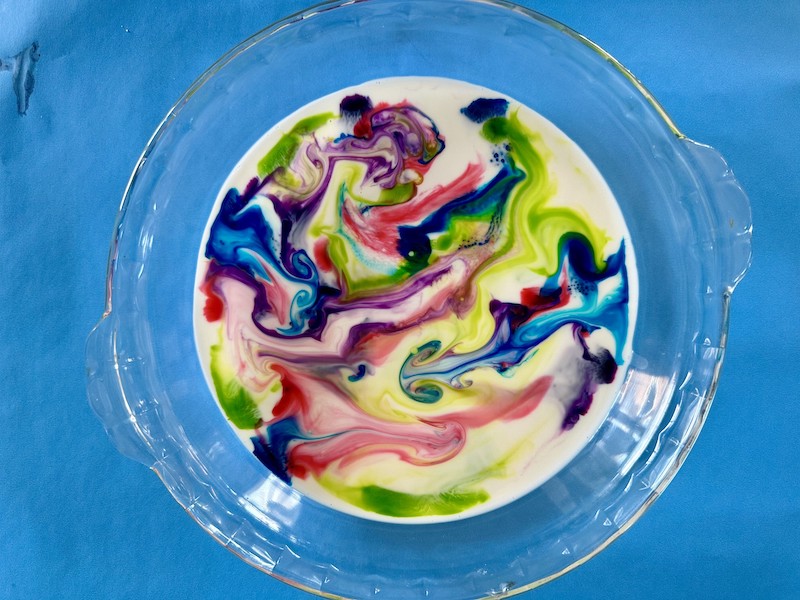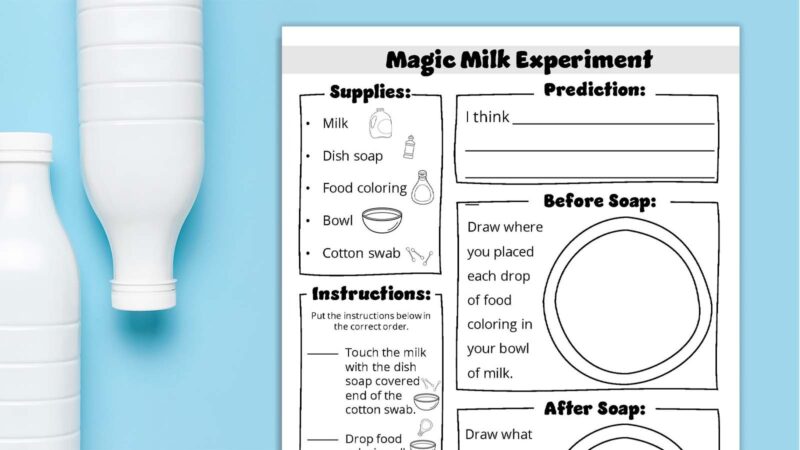

Milk, Food Coloring, and Dish Soap Experiment
By: Author Susanne Williams
Posted on Published: December 5, 2020 - Last updated: December 29, 2023
Are you looking for easy kitchen experiments for your kids? Then give this cool Milk, Food Coloring, and Dish Soap Science Experiment a try.
It is set up within minutes and is so much fun even for toddlers and preschoolers. Let’s get right into it.

There are affiliate links in this post, meaning, at no additional cost to you, I will be compensated if you click through and take action. As an Amazon Associate, I earn from qualifying purchases.
How to Create Your Own Milk, Food Coloring, and Dish Soap Experiment at Home
Did you ever try this easy dish soap milk experiment?
My kids love it and call it the milk magic experiment! It is such an easy setup it is unbelievable for the amount of fun and wonders you will see in your children’s eyes.
Since I found this fun dish soap milk experiment they are asking for more and more food coloring experiments. They simply loved it!
Food Coloring Experiment Materials
But let’s have a look at our magic milk science experiment first. Here is what you will need to fascinate your children:
- plate or bowl
- 2% or whole milk
- food colors
- dishwasher soap
- 1 Q-Tip or cotton ball

Are you interested in more kid’s activities and arts & crafts? Subscribe to our newsletter now and never miss an update! Click here
Milk With Food Coloring Experiment Instructions
Follow our easy step-by-step tutorial to get great results:
Step 1: Prepare your Plate
- First, fully cover the bottom of your plate with milk. This food coloring trick works best with 2% or whole milk!
Step 2: Add Food Coloring
- Then choose different food colors and add 3-4 drops of each color to the milk as shown in the picture below. We used yellow, green, and blue.

Step 3: Prepare your Q-Tip
- The secret to our milk, soap, and food coloring experiment is the following: Dip your Q-tip or cotton ball in dish soap till it is fully covered.
Step 4: Milk Painting
Now it is time to let the magic happen and watch your color explosion.
Place your soaked Q-Tip in the center of the milk. You will see how the colors dance magically across the milk surface and create wonderful milk paintings.

Did you know STEM Education has many benefits? Read all about them here. Your kids also might enjoy our popular Sherbet Experiment , explore this classic Skittle Experiment , or enjoy making a Coke Volcano . I also recommend one of these 15+ Water Experiments for Kids next.
Magic Milk Food Coloring Experiment Explained
After your children did their own kid’s experiment with food coloring, they might have some questions for you.
How does this coloring experiment work?
What happens when you drop the soap?
What is the science behind this fun milk experiment?
So let’s have a look at the magic milk experiment explanation:
First, they will have to know that milk is a mixture of water, fat, vitamins, and minerals.
The magic ingredient to this milk, soap, and food coloring experiment is soap. The soap lets the food coloring dance.
Without soap, the cotton ball wouldn’t do anything else than soak itself full of milk.
Soap incorporates water-loving (hydrophilic) and water-fearing (hydrophobic) ends. Water molecules are polar molecules, which means they can dissolve other polar molecules.
Fat and oil molecules on the other hand are nonpolar molecules that can not dissolve in water!
When you add the soap to your milk food coloring mix, the water-fearing end of the soap molecules breaks up the fat molecules, and the water-loving end of the soap molecule links up with the water molecules.
Therefore the dish soap connects the fat and water. As a result, the molecules of fat can be carried by the water molecules.
Now when the soap connects with the fat, the food coloring gets pushed around everywhere resulting in a color explosion.
When the dish soap is done connecting with the fat our food coloring eruption will slow down and eventually stop.
Take Your Milk Food Coloring Experiment Further
Let’s try around and switch your switch our milk and food coloring experiment up.
Try using water instead of milk. Will it still erupt the color?
What happens when you use 1% milk versus 2% milk or whole milk? Will you see a difference and why?
Let your children and students make their hypotheses and observations. They will have a lot of fun while learning!
This is such a fun food coloring experiment! If you want to see the milk, food coloring, and dish soap experiment in action, watch this video!
Now I would like to hear from you!
How did your kids enjoy this fun science experiment with food coloring? Did they enjoy coloring milk? Either way, let me know by leaving a comment below right now. I’d love to hear from you!
Pin this Milk, Food Coloring, Dish Soap Experiment
Don’t forget to save this easy milk, food coloring, soap experiment on Pinterest for later! Be sure you are following along with Lil Tigers.
Milk, Food Coloring, Dish Soap Experiment

Ingredients
- Milk (2% or Whole Milk)
- Food Coloring
Instructions
- Now you can place your soaked Q-Tip in the center of the milk. You will see how the colors dance magically across the milk surface.
Wednesday 30th of November 2022
Hi my name is Fanta and i will like to know what is the year of publication because i need it for a science fair project and it's due Dec 15. So you can message my in your free time Have a wonderful day/night
Thursday 1st of December 2022
Dear Fanta, thx for reaching out. I wrote my post on the 20/12/05 . I hope that helps you. Good luck with your science fair! All the best Susanne from Lil Tigers
- Grades 6-12
- School Leaders
FREE Thanksgiving Worksheet Bundle for Last-Minute Activities 🦃
Magic Milk Experiment: How-To Plus Free Worksheet
This classic experiment teaches kids about basic chemistry and physics.

This fun experiment is a classic for a reason! In the magic milk experiment, kids learn about simple chemical reactions and physical properties using only a few ingredients. Read on to see how to do the experiment, and fill out the form on this page to grab your free recording sheet.
How does the magic milk experiment work?
In this experiment, you pour some milk into a shallow dish. You then add drops of food coloring to the surface of the milk. Using a cotton swab dipped into dish soap, you lightly brush the surface of the milk. The dish soap breaks the surface tension of the milk, and the soap molecules try to attach to the fat molecules in the milk. This causes swirls and bursts of fun rainbow colors.
What does the magic milk experiment teach?
This experiment teaches us about the science of molecules and how substances interact. The soap breaks down the fat molecules and makes them move apart, showing us a simple but fascinating example of chemistry in action!

Is there a magic milk video?
This video shows two different ways to do the magic milk science experiment, using very similar ingredients.
Materials Needed

To do the magic milk experiment, you will need:
- Shallow bowl or plate
- Milk, blue dish soap
- Cotton swabs
- Food coloring (inexpensive works better than gel coloring)
Our free recording sheet is also helpful— fill out the form on this page to get it.
Magic milk experiment steps:
1. pour milk into a shallow dish or bowl, just enough to cover the bottom..

2. Add drops of food coloring all over the surface of the milk.

3. Dip the end of a cotton swab into a separate dish of blue soap.

4. Lightly brush the top of the milk with the cotton swab, and watch what happens!

Grab our free magic milk experiment worksheet!

Fill out the form on this page to get your worksheet. The worksheet asks kids to guess the correct order of the steps in the experiment. Next, kids must make a prediction about what they think will happen. They can use the provided spaces to draw what happens before and after they add the dish soap. Did their predictions come true?
Additional Reflection Questions
- What happened when we added the soap to the milk?
- Why do you think the colors appeared on the milk’s surface?
- What do you think would happen if we added more soap to the milk?
- What do you think would happen if we used a different liquid instead of milk?
Can the magic milk experiment be done for a science fair?
Yes! If you want to do the magic milk experiment for a science fair, we recommend switching up some of the variables. For example: Does the fat content of the milk matter? Does the type of dish soap matter? Form a hypothesis about how changing the variables will impact the experiment. Good luck!
Looking for more experiment ideas? Check out our big list of experiment ideas here.
Plus, be sure to subscribe to our newsletters for more articles like this., you might also like.

76 Easy Science Experiments Using Materials You Already Have On Hand
Because science doesn't have to be complicated. Continue Reading
Copyright © 2024. All rights reserved. 5335 Gate Parkway, Jacksonville, FL 32256

- Science Notes Posts
- Contact Science Notes
- Todd Helmenstine Biography
- Anne Helmenstine Biography
- Free Printable Periodic Tables (PDF and PNG)
- Periodic Table Wallpapers
- Interactive Periodic Table
- Periodic Table Posters
- Science Experiments for Kids
- How to Grow Crystals
- Chemistry Projects
- Fire and Flames Projects
- Holiday Science
- Chemistry Problems With Answers
- Physics Problems
- Unit Conversion Example Problems
- Chemistry Worksheets
- Biology Worksheets
- Periodic Table Worksheets
- Physical Science Worksheets
- Science Lab Worksheets
- My Amazon Books
Magic Milk Science Experiment for Kids Recently updated !

Nothing happens if you drip food coloring onto milk, but once you add a drop of dishwashing liquid, the milk turns into a swirling wheel of color. Here’s how to perform the magic milk science experiment and a look at how it works.
Magic Milk Materials
This is a great science project for kids because all you need is milk, food coloring, and dishwashing liquid. It’s also easy on your pocketbook because you only need a little of the ingredients.
- Food Coloring
- Dishwashing liquid
How to Do the Magic Milk Science Experiment
- Pour enough milk to cover the bottom of a small place or shallow saucer.
- Add a few drops of food coloring. You don’t need to use different colors, but if you do, you can explore how colors combine to make new ones.
- Observe how boring this is. The food coloring drops stay where you put them and may even sink into the milk and disappear.
- Drip a droplet of dishwashing liquid onto the center of the milk. You don’t need to stir the milk. The colors immediately start to swirl on their own.
How the Magic Milk Experiment Works
Adding food coloring to milk doesn’t have much of an effect. Yes, you can color the milk if you stir it, but if you don’t stir it the color spreads by diffusion . Diffusion is a slow process and not very interesting to watch.
When you add dishwashing liquid, the colors start to swirl. Dishwashing liquid is a detergent. Detergents lower the surface tension of the water in the milk, making it easier for the ingredients on the plate to mix. You can observe surface tension if you pour water or milk into a glass and note you can overfill the container slightly. The anti-gravity water science trick also relies on surface tension.
But, that’s not all detergent does. Detergent is an emulsifier . Each detergent molecule has a hydrophobic (“water-fearing”) and hydrophilic (“water-loving”) portion. The hydrophilic portion orients toward water molecules, while the hydrophobic portion orients toward fat molecules. The end result is that detergent forms tiny spheres called micelles that separate the fat from the water. Basically, an emulsifier helps two immiscible (unmixable) liquids mix. The food coloring swirls throughout the milk as the detergent forms micelles around fat globules within it. The fat content of the milk matters. Skim milk contains very little fat, so the detergent doesn’t have a big effect on it. 2% milk and whole milk work much better for the magic milk project because they contain enough fat to cause a visible reaction between the detergent and milk.
From Project to Science Experiment
Science projects work due to scientific principles. For young explorers, you can explain that detergent changes the properties of milk so colors added to it mix better. Explain that the same process happens when you wash dishes. The detergent makes it easier for oil and grease to lift from dishes and get rinsed away. Also, this is a great project for kids to explore colors. They can see that blue and yellow combine to make green, red and blue combine to make purple, and so on.
But, older children can turn the science project into a science experiment. The difference is that an experiment uses the scientific method . In a nutshell, an investigator observes the project, makes a prediction or forms a hypothesis about what will happen if one thing is changed, and then conducts and experiment to see if the prediction was correct. Here are some ideas of factors to change to turn the magic milk project into a true magic milk science experiment.
- What happens if you increase the fat content of milk? You can compare skim, 2% milk, whole milk, and half-and-half. Or, you can mix oil in with milk before continuing the project. Is there a point where the thickness of the milk slows down the reaction?
- Does the project work with water? With vegetable oil? What happens if you mix water and oil and try the project?
- What happens if you sprinkle glitter onto the milk before adding the detergent?
- Temperature affects the rate of many processes and chemical reactions. Is there any difference if you use very color milk compared with hot milk?
Related Posts

IMAGES
VIDEO